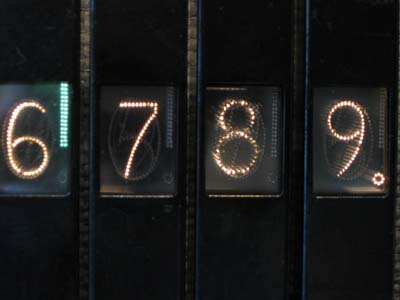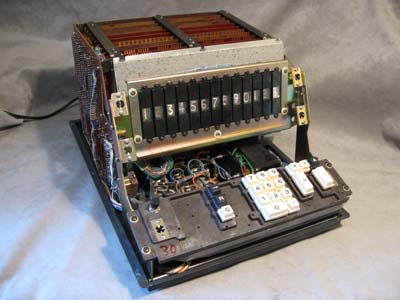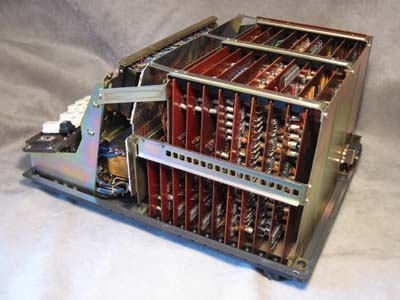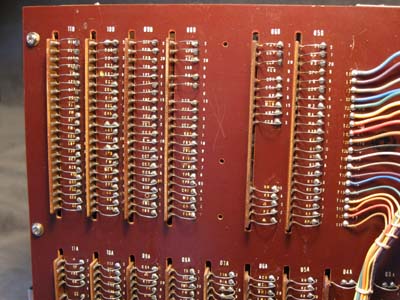|
|
|
The first calculator from Canon and one of the first electronic calculators. Constructed from discrete Germanium transistors and diodes.
| Notes: |
|

The keyboard and 13-digit display. The right arrow key shifts the displayed number one digit to the right. This can be used for correcting entry mistakes, although it was probably intended primarily for reducing the resolution of the result of a division. Division leaves the result left-aligned in the display, typically filled with fractional digits to the right of decimal point. Further operations can easily result in overflow, so being able to remove decimal point digits can be quite useful. While the 130 does not have a third number memory for sum-of-products operations, the "A" switch allows the calculator to be set into a mode in which the result of sequential multiplications will accumulate, albeit without being able to observe the result of the individual multiplications. In essence, the "A" switch inhibits clearing of the result memory before a multiplication. The "R" key recalls the total. |

Close-up of the display. Each digit is constructed from 12 clear plastic sheets layered into a sandwich. Each layer contains one symbol, the symbols are formed from a pattern of dot indentations in the layer. In addition to the 10 numerals, there is a decimal point symbol and a separator "bar". Each symbol or layer is illuminated from the edge by an incandescent bulb, the light being refracted out to the viewer by the disruption at the indentations. The layering is observable in the photo. The "7" is on a layer near the front, the "8" is situated nearer the rear, with dots of other numerals obstructing the view of the "8" somewhat. Rick Bensene's sources indicate these displays were made by Canon. General Radio also made or used a similar display. Some pop culture trivia: similar displays can be seen on the timer of the nuclear weapon in the James Bond movie "Goldfinger" from 1964, I suspect they were on a piece of GR test equipment. The green bar between the "6" and "7" is the multiplication separator. In contrast to modern calculators, during multiplication, both operands are entered and are visible in the one display. |

Cover removed. The logic is contained on 11 circuit boards behind the display, hand-wired to a backplane on the left side. The power supply is below the keyboard. |

Right-side internal view. |

Left-side internal view, showing the backplane connecting all the logic boards. Also visible is the large bundle of wires connecting the 13 digits of the display to the logic boards. The display is not multiplexed, so each digit has 12 to 13 wires (10 numerals, decimal point, separator & common) connecting it to the logic. |

Closer view of the backplane. The logic boards were patterned and designed for the use of edge connectors, however edge connectors were not installed in this unit. Instead, as can be seen, the boards are soldered directly to the backplane. Perhaps eliminating the connectors reduced costs, and the soldered connections may have improved the reliability of the calculator slightly over mechanical connections. The significant downside however, is the unit is now essentially unserviceable as the logic boards cannot be accessed without unsoldering dozens to hundreds of connections. Fortunately - to date - this unit has not required servicing at the board level, although it can be expected to be a problem in the future. Access would also be nice to enable reverse-engineering of the unit. In contrast, see the backplane of a Canon 161. |
| 100206 | |
| 1966 (transistors stamped with 6C, wire stamped with 1966) | |
| 02 Nov 1999 | |
| Brownlee Office Equipment. According to seller: This is one of the first three units sold in Western Canada after seller obtained distribution rights for Canon calculators. Sold to B.C. Tel in mid-1960s, then traded back in to seller a couple of years later. In storage from late-1960s to 1999. | |
| Good physical condition, fully functional except for a few burned-out numeral lamps. | |
| Fully functional (04 Sep 2000). |
| Nov 1999 | |
| Cleaned. |
| Nov 1999 | |
| Original power connector replaced with IEC standard. |
| Nov 1999 | |
Lamp repairs:
|
| 04 Sep 2000 | |
Lamp repairs:
|
| 27 Oct 2021 | |
| In digit 10^10, "9" displays as "8" & "9".
9 is being decoded to 8 & 9.
Not repaired at this time, otherwise fully functional.
Also, transistors counted. |
|
Canon 130
Calculators | Integrated Circuits | Displays | Simulations EEC |
bhilpert |